| کد مقاله | کد نشریه | سال انتشار | مقاله انگلیسی | نسخه تمام متن |
|---|---|---|---|---|
| 5792507 | 1109639 | 2012 | 9 صفحه PDF | دانلود رایگان |

A five-factor Central Composite Orthogonal Design was adopted to study simultaneous effects of some processing variables such as NaCl (0-2%), fat (10-30%), ascorbic acid (0-600 ppm), cooking temperature (150-230 °C) and cooking time (5-15 min) on physicochemical properties and heterocyclic aromatic amine (HAA) contents of cooked beef patties. The HAAs analyzed were 2-amino-3-methylimidazo[4,5-f]-quinoline (IQ), 2-amino-3,8-dimethylimidazo[4,5-f]-quinoxaline (MeIQx), 2-amino-3,4-dimethylimidazo[4,5-f]-quinoline (MeIQ), 2-amino-3,4,8-trimethylimidazo[4,5-f]-quinoxaline (4,8-DiMeIQx) and 2-amino-1-methyl-6-phenylimidazo[4,5-b]-pyridine (PhIP), as quantified by high-performance liquid chromatography with photo-diode array detection (HPLC-UV/DAD). It was found that ascorbic acid decreased; however, fat, cooking temperature and time levels increased the contents of IQ, MeIQx, MeIQ and PhIP. In addition, estimated ridge analysis was conducted to find values of the processing variables that maximize and minimize the five HAA contents, revealing that the results obtained would be useful for meat industry aiming to decrease HAA content in cooked meat products.
⺠Effects of some processing variables on heterocyclic amine (HAA) content were analyzed. ⺠Response Surface Methodology was conducted to find optimum values of variables. ⺠Five HAAs were analyzed. ⺠Ascorbic acid was found to have a decreasing effect on HAA content. ⺠Increase in fat, cooking temperature and time had increasing effect on HAA contents.
Journal: Meat Science - Volume 91, Issue 3, July 2012, Pages 325-333